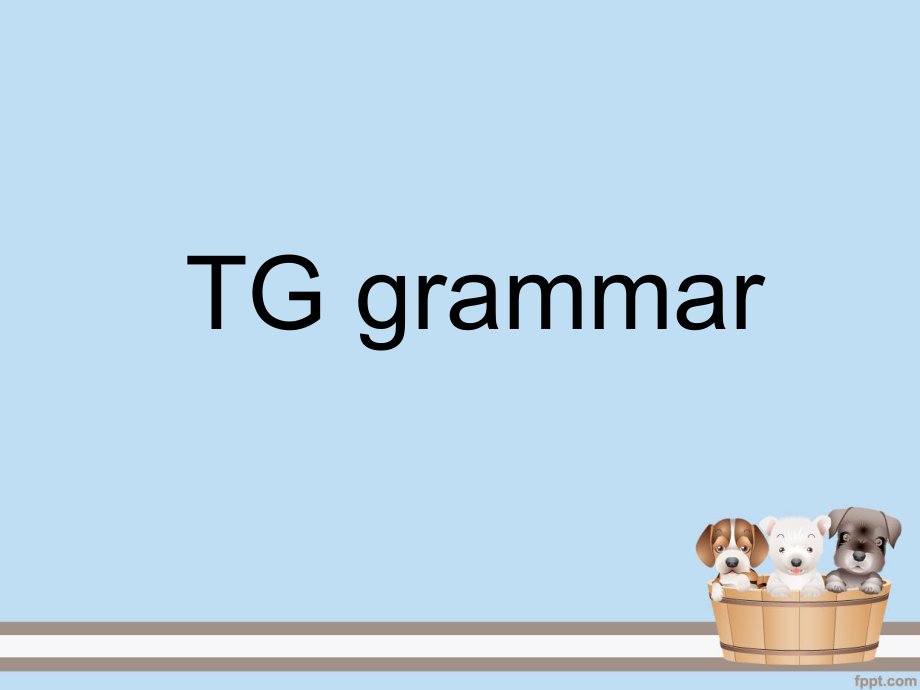 语言学TG grammar
语言学TG grammar



《语言学TG grammar》由会员分享,可在线阅读,更多相关《语言学TG grammar(21页珍藏版)》请在装配图网上搜索。
1、 TG grammarBackground about TG grammar In the late 1950s, Noam Chomsky founded a new theory in America and gave violent impact on the structuralist descriptive linguistics. He tried to open up a route when he found that the classification of structural elements of language according to distribution
2、and substitution had its limitations. From this practice Chomsky gradually established the well-known TG grammar.Noam Chomsky: He is an American linguist. Sometimes described as the father of modern linguistics.Chomskys contribution: Innateness Hypothesis,Universal Grammar and Particular Grammar,Com
3、petence and Performence, Deep structure and Surface structureWhat is TG Grammar? TG grammar, first put forward by American linguist Noam Chomsky in the 1950s, is a reaction to traditional and structuralist linguistics. Different from the structuralism based on behaviorism in psychology, Chomsky argu
4、es for a mentalist approach to study language. In his school, the word grammar is given a special significance. Grammar, in Chomskyan sense, refers to ones innate competence of language. The main focus then was to account for the creativity of human language. One of his famous tenets is human beings
5、 have the ability to create and understand an infinite number of sentences with a finite set of rules. The new theory seemed to work well in explaining some of the sentences such as embedded structures, active v. passive structures etc.Main features of TG grammar: 1.Rationalism 2.Innateness 3.Deduct
6、ive methodology 4.Emphasis on interpretation 5.Formalization 6.Emphasis on linguistic competence 7.Strong generative powers 8.Emphasis on linguistic universalsTwo Aspects of TG Grammar Surface Structure: The structure of sentence as it is actually produced or understood, the syntactic structure of s
7、entence which a person speaks, hears, reads or writes. Deep Structure: The deep structure is much more abstract and is considered to be in the speakers, hearers, writers or readers mind.Competence and performance Competence - the ideal users knowledge of the rules of his language. Performance - the
8、actual realization of this knowledge in linguistic communication. Chomsky looks at language from a psychological point of view and to him competence is a property of the mind of each individual.Five Stages of TG Grammar 1The classical theory (1955-1965):aims to make linguistics a science. 2The stand
9、ard theory (1965-1970):deals with how semantics should be studied in a linguistic theory. 3 The extended standard theory (1970-1980):focuses discussion on language universals and universal grammar. 4The revised extended standard theory (GB) (1980-1992):focuses discussion on government and binding. 5
10、The minimalist program theory(1992-):a further revision of the previous theory.Language acquisition device This is a key concept in innatist views of language learning which postulate that all people are born with some knowledge of language. LAD, or called as UG subsequently, is an inborn capacity f
11、or any kind of language. However, this should not be taken as that we are born with knowledge of the particular rules of our own language, but rather LAD/UG consists of general or universal principles of all languages. This innate knowledge allows us to select a particular language based on a few in
12、stances of input and produce very complex output that we he have never encountered before. Chomskys innateness hypothesis is based on his observations that some important facts can never be otherwise explained adequately. 1. Chomsky noticed that children learn their native language very fast and wit
13、h little effort. Considering the fact that the small children are not yet intellectually mature in any other fields, this is surprisingly fast. The first language acquisition invariably takes place without formal, explicit instruction: the input is degenerate data, but the output is a perfect langua
14、ge system. 2. Children in the world learn their mother tongue in very different environments, however, they follow more or less the same stages in their linguistic development: babbling stage, nonsense word stage, holophrastic stage, two-word stage, developing grammar, near-adult grammar and full co
15、mpetence. 3. During the limited period of time, from limited exposure to speech, the child learns the total grammar of the language. He can not only produce and understand not only sentences he has heard but also the sentences he has never heard before. What he learns seems to be a set of rules rath
16、er than individual sentences.Differences between structual grammar and TG grammar. First, Bloomfield defines language as a set of utterances and a set of “lexical and grammatical habits” Chomsky defines the language as a set of rules or principles. Secondly, the two grammars have different aims in l
17、inguistics. For Structural Grammar the aim of linguistics is to describe one or set of languages, such description is often evaluated in terms of the use to which it is going to be put. For Chomsky, the aim of linguistics is to produce generative grammar which captures the tacit knowledge of the nat
18、ive speaker of his language. Thirdly, the two grammars make use of different type of data in their analysis. The structralists only make use of naturally occurring utterances, observed and observable. They are not allowed to consult the informant whether a sentence is grammatical or not. In contrast
19、, Chomsky and his followers are interested in any data that can reveal the native speakers tacit knowledge. They seldom use what native speakers actually say; they rely on their own intuition. Fourthly, the two grammarians employ different methods. The structuralists methodology is essentially induc
20、tive. Bloomfield said, “the only useful generalization about language is inductive.” whereas, Chomskys methodology is hypothesis-deductive, which, according to Chomsky himself, operates at two levels: (a) the linguist formulates a hypothesis about the language structure- a general linguistic theory;
21、 this is tested only by grammars for particular languages, and (b) each such grammar is a hypothesis on the general linguistic theory. Finally, the two grammars view language learning differently. The structuralists follow empiricism in philosophy and behaviorism in psychology. Chomsky follows rationalism in philosophy and mentalism in psychology.无垠文海 邀你畅享更改PPT母版功能键:PPT文档讨论群:253147947
- 温馨提示:
1: 本站所有资源如无特殊说明,都需要本地电脑安装OFFICE2007和PDF阅读器。图纸软件为CAD,CAXA,PROE,UG,SolidWorks等.压缩文件请下载最新的WinRAR软件解压。
2: 本站的文档不包含任何第三方提供的附件图纸等,如果需要附件,请联系上传者。文件的所有权益归上传用户所有。
3.本站RAR压缩包中若带图纸,网页内容里面会有图纸预览,若没有图纸预览就没有图纸。
4. 未经权益所有人同意不得将文件中的内容挪作商业或盈利用途。
5. 装配图网仅提供信息存储空间,仅对用户上传内容的表现方式做保护处理,对用户上传分享的文档内容本身不做任何修改或编辑,并不能对任何下载内容负责。
6. 下载文件中如有侵权或不适当内容,请与我们联系,我们立即纠正。
7. 本站不保证下载资源的准确性、安全性和完整性, 同时也不承担用户因使用这些下载资源对自己和他人造成任何形式的伤害或损失。
